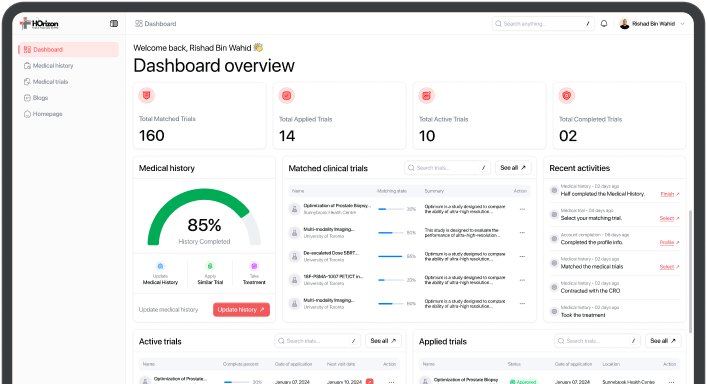
Study of Hydroxychloroquine With FOLFIRI and Bevacizumab in DTP-high Metastatic Colorectal Cancer
Contact information
Eric Chen, MD
Sunnybrook Odette Cancer Centre
Toronto, Ontario, Canada, M4N 3M5
Basic information
Age
155 Enrollment
Trial Details
Brief Summary
This is a two arm, 2-center, Phase II, study of 5-FU, irinotecan, bevacizumab (FOLFIRI-beva) and hydroxychloroquine (HCQ) in patients with previously untreated metastatic colorectal cancer (mCRC). Up to 155 patients will be screened for DTP-signature and up to 31 evaluable patients who are determined to be DTP-signature high will be treated with FOLFIRI-beva and HCQ. Patients will continue to receive treatments until evidence of disease progression, intolerable side effects, withdrawal of consent or death.
Official Title
A Phase II Study of 5-FU, Irinotecan, Bevacizumab and Hydroxychloroquine in Drug-Tolerant Persister (DTP)-Selected Patients With Metastatic Colorectal Cancer
Selection Criteria
Eligibility Inclusion Criteria
-
- Histologically confirmed colorectal cancer, not amenable to curative resection.
- Microsatellite stable/mismatch repair proficient (MSS/pMMR) colorectal cancer.
- No prior systemic therapy for metastatic disease.
- Evaluable disease based on RECIST 1.1 criteria.
- Adequate hematological, hepatic and renal functions
- Eastern Cooperative Oncology Group (ECOG) Performance status 0-1.
- Estimated life expectancy of > 6 months.
- Negative pregnancy test for female patients with child-bearing potential.
- No history of retinal disorder.
- No history of glucose-6-phosphate dehydrogenase deficiency (G6PD) .
- Considered to be DTP-signature high to receive HCQ treatment
Eligibility Exclusion Criteria
-
- Women who are pregnant or nursing.
- Have received radiotherapy, chemotherapy, biological therapy, or investigational treatment less than four weeks (six weeks for nitrosoureas or mitomycin C) prior to first dose of FOLFIRI-beva or have not recovered from all acute toxicities from prior treatments to grade 1 or less, with the exception of alopecia and those deemed not to affect safety assessment.
- Have concurrent malignancy with exception of malignancy that was treated curatively and without evidence of recurrence within 3 years of study enrollment, or fully resected basal or squamous cell skin cancer and any carcinoma in situ which are considered to be of low risk of recurrence.
- Have had major surgery within 28 days of study enrollment. Placement of a venous access device within 28 days of starting therapy is allowed.
- Have any medical condition that would impair the administration of oral agents including significant bowel resection, inflammatory bowel disease or uncontrolled nausea or vomiting.
- Known central nervous system metastasis. Patients with history of central nervous system metastases are eligible if they are clinically and radiographically stable for at least 3 months and not taking steroids or anticonvulsants.
